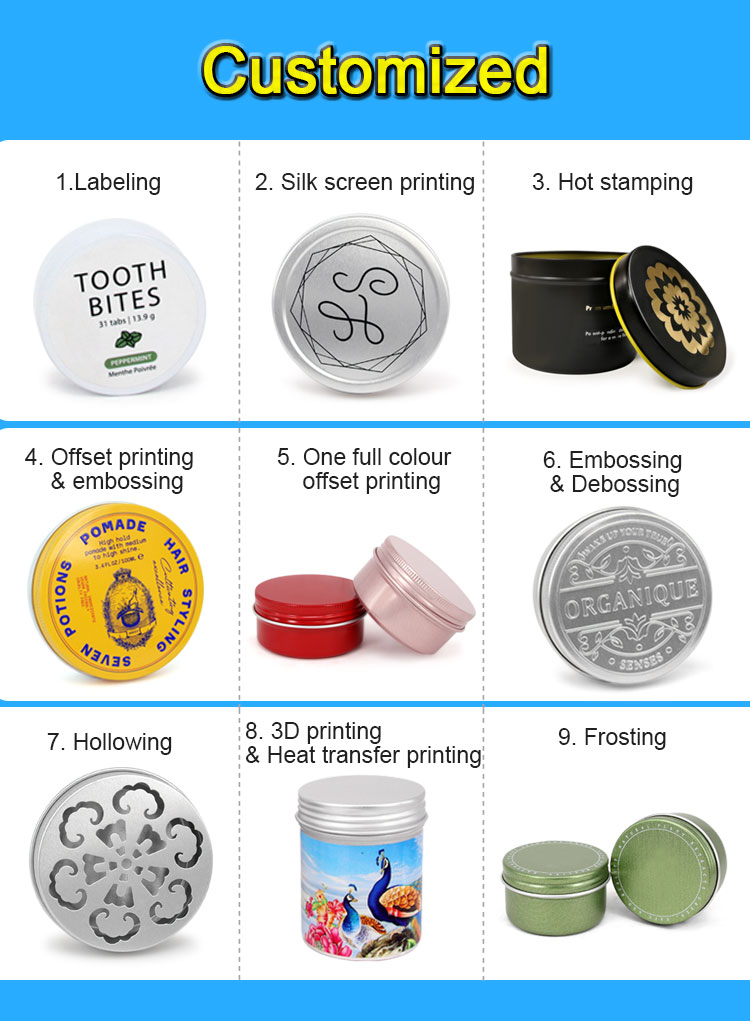1. Printing principle of tinplate cans:
Tinplate can printing has special requirements for ink:
(1) The printing ink is required to have good adhesion and mechanical properties
Because tinplate cans are mostly made into food tin cans, tea tin cans, biscuit tins, etc., and tinplate cans need to go through more than ten processes such as cutting, bending, stamping, and stretching, the printing ink is required to be better for iron plate tinplate cans. The adhesion and corresponding mechanical properties. In order to improve the ink adhesion, it is necessary to print white ink on the tinplate before printing. White ink is the basic hue of all printed patterns and has high brightness. After adding other high-energy inks, the brightness of all colors can be improved to form color gradations.
(2) The requirements of tinplate can printing for printing white ink
The surface of the tinplate can is silver-white (or yellow) with metallic luster. It needs to be painted or printed white before printing the color graphics. Due to the limited ink coating capacity, the monochrome machine often needs to print white twice. The whiteness can reach 85%. White is an important standard for the printing quality of tinplate cans. It requires that the white ink and the primer have a good bonding force. After many times of high-temperature baking, it will not yellow, and it will not decolorize after high-temperature steaming. Applying primer can improve the adhesion of tinplate cans and have good adhesion to white ink. The primer usually used is epoxy amine based, light in color, will not yellow after repeated baking, does not age, has good elasticity and impact resistance.
(3) Requirements for color ink in tinplate can printing
In addition to certain water resistance, color inks printed in tinplate cans also have special requirements. Since the surface of tinplate cans does not penetrate solvents and needs to be dried, the ink should be thermosetting. There are high requirements for the coloring ability and durability of pigments. In addition to the basic properties required by general offset printing inks, according to the characteristics of the printing iron, it should also have the characteristics of heat resistance, strong ink film adhesion, impact resistance, good hardness, cooking resistance and light resistance.
(4) Drying process of tinplate can printing ink
In tinplate can printing production, the drying of ink is a complex physical and chemical reaction process. It is necessary to reasonably control the drying speed of the ink and master the physical and chemical mechanism of ink drying in order to effectively perform fast printing operations and ensure product quality. Drying the ink too fast will reduce the normal transfer performance of the ink and affect the normal production; cause the printing plate and the ink roller surface to become weaker, the color of the ink becomes lighter, the ink becomes dry, and the ink transfer is blocked; the drying layer of the printing plate is outward Expansion; Excessive desiccant will increase ink adsorption and make the blank part dirty. However, if the ink dries too slowly, it will cause difficulties in overprinting, blocking, and blocking. , The hardness is reduced; it is easy to cause scratches during the transmission process. Therefore, the drying speed of the ink should be appropriate, not too fast or too slow.
(5) Special structure of tinplate can printing equipment
Because the substrate is tinplate, the auxiliary mechanism of the printing machine is different from that of the paper offset printing machine. Tinplate is insoluble in water and does not absorb solvents, so the ink in tinplate tanks needs to be baked at a high temperature to solidify the conjunctiva after the solvent volatilizes. Therefore, a drying chamber is usually required during the printing process. The full-automatic printing line for tinplate cans is generally about 40-55 meters, and the equipment is sophisticated and huge. In addition, the tinplate printing machine is controlled by a single and two-piece magnet. The high hardness of the tinplate material also determines that the advanced continuous iron transmission structure cannot be used in the printing process, which is different from the offset printing machine in the structure of pushing, positioning and stacking parts. .
2. The printing process of tinplate cans
1) Lithographic printing process of tinplate cans:
The biggest feature of lithographic printing is that the printed pattern (the ink-stained part) and the non-printed pattern are on the same plane. Lithographic printing is to print ink on a rubber roller, and then use a pressure roller to print on the tinplate. Because the printing plate will not directly touch the tinplate ink, it will not stain, so it is suitable for high-quality printing, even if the tinplate finish is not good, it will be overcome.
2) The bronzing process of tinplate cans:
After heating the tinplate, the post-processing process of using tin foil to separate the patterns and imprinting on the tinplate has been widely used because of its bright visual effects.
3) The letterpress printing process of tinplate cans:
Letterpress printing means that the graphic part on the layout is higher than the non-graphic part. The ink on the ink roller can only be transferred to the graphic part on the layout, and the non-graphic part does not require ink, thus completing the printing. A traditional printing technique that emboss the tinplate after rolling ink on the engraving of the tinplate can adjust the pressure printed on the engraving of the tinplate as needed to form a deeper three-dimensional feeling.
4) Inkless embossing process of tinplate cans:
No heating, no tin foil, no ink; a processing technology that is directly stamped on the tinplate, suitable for presenting the original texture of the tinplate or expressing it in a simple style.
5) UV printing process of tinplate cans:
It will dry printing after irradiating ultraviolet light with special ink, which is suitable for tinplate that is not easy to dry, or other flat materials, such as aluminum products, wood boards, etc.
6) Screen printing process of tinplate cans:
Screen printing is a method of hollowing out the print on the printing plate and allowing the ink to transfer through the mesh. When the substrate is made of tinplate, aluminum plate, plastic and other materials, or curved surfaces such as boxes, cans, or special printing needs such as floating surface effects, screen printing is mostly used.
7) Lithographic printing process of tinplate cans:
Plane printing is a relatively mature printing method at present. It is a fast and stable large-scale printing technology. It is suitable for mass printing of tinplate cans. It is a very good and economical choice when the printing volume is large.
8) Screen printing process of tinplate cans:
Screen printing is a traditional process of printing with a screen made of nylon thread. In metal printing, only a single color or several colors can be used for register printing. Because it belongs to semi-manual production, if there is color overlap, it is not suitable for products with high precision requirements.
9) Screen printing process of tinplate cans
After the surface of the tinplate tank is silk-screened, it must be pre-treated. The pre-treatment process of the surface of the tin can is also called pre-press processing. The pretreatment methods for the surface of iron cans include degreasing, polishing, wire drawing, oxidation, sand surface treatment, painting, etc. This method can be used alone or in combination according to the different requirements of the product and the condition of the underlying material to achieve the desired effect.



For further customized logo of tin cans, please kindly send us an email, we will provide you more detailed customization information.










